I probably inherited my love of travel from my mom. Even as a child, we traveled abroad frequently, and she’s continued exploring since my sister and I left the nest and she retired. These days, she mostly travels solo (with help from travel agencies) or with friends. For her 75th birthday, I definitely wanted to give her a travel-related gift, so I started looking for a destination where she probably wouldn’t go alone (and I’d worry about her going solo), but wasn’t too far from us since I’d already committed most of my annual vacation days to a longer trip, as usual.
That’s how I settled on Egypt, where strangely enough, neither of us had been before. The pyramids are something you need to see at least once in your lifetime, and while you could easily spend much more time in this ancient country blessed with archaeological treasures, you can tour the pyramids and their surroundings over a long weekend. Despite multiple flight cancellations, we finally managed to take our four-day trip in late January.
This travel report will be a bit different from my usual ones, because my “travel style” was also different from normal. Understandably, traveling with my 75-year-old mom, I was much less “adventurous” than usual and focused much more on comfort and predictability when planning. So I’ll briefly describe what we saw during our few days there and what to watch out for if you’re planning to surprise an elderly family member with a similar trip.
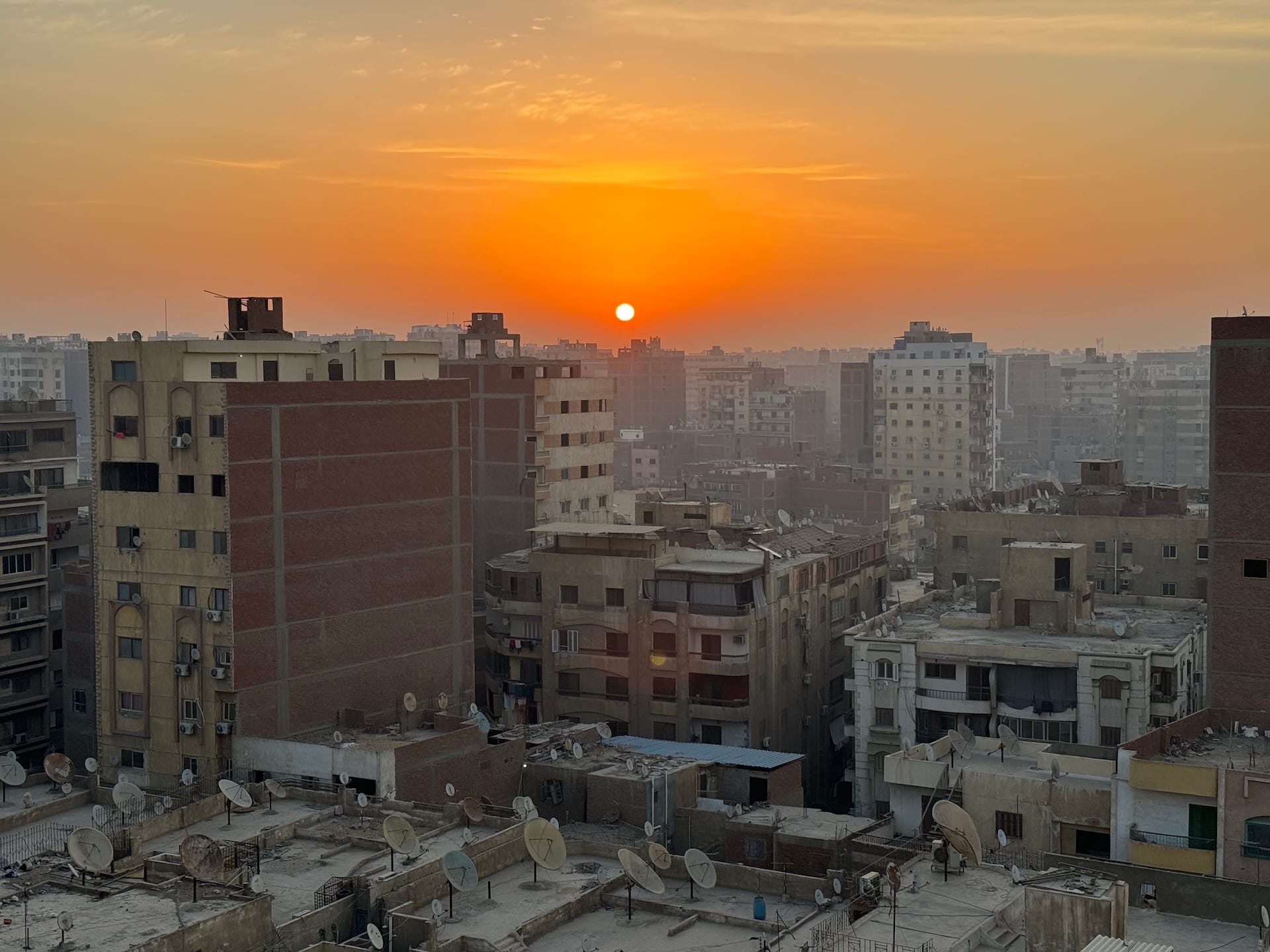
Egypt Visa Requirements: E-Visa Application Guide
Currently, travelers from 78 countries can enter Egypt using an e-Visa, and we chose this option because it seemed much simpler than trying to exchange money at the airport upon arrival and apply for a separate visa. The e-visa can be easily processed online on this website, and the single-entry visa currently costs $25 USD.
Entry was relatively quick, the border control officer was very kind and cheerful, so everything went perfectly smoothly.
Apply for your e-visa at least 7 days before departure to avoid any last-minute issues. The official government website is the safest option for visa applications.
Cairo Airport Transportation: Sphinx vs Cairo International
We didn’t arrive at Cairo’s main airport, but rather at the newer and less “established” Sphinx International Airport (SPX), which primarily serves low-cost airlines but is much closer to Giza. However, if you’re not coming from Europe or the Middle East, you’ll most likely arrive at Cairo International Airport (CAI) as your gateway to the country.
From Sphinx Airport, there’s practically no public transportation to the city, or at least I couldn’t find any. Besides, I probably wouldn’t have started our introduction to Egypt with local public transport anyway, traveling with my mom. Having considered Uber as an option (and reading reports that drivers don’t like coming out there in the evening), I decided in a very un-me way to take advantage of the hotel’s offer and use their airport transfer service, which was even free one way and cost $20 USD on the return.
During the rest of our stay, we used Uber throughout (when we weren’t being driven around during tours). The only place where it was difficult to find a car was at the Grand Egyptian Museum; everywhere else, we had a car almost immediately.
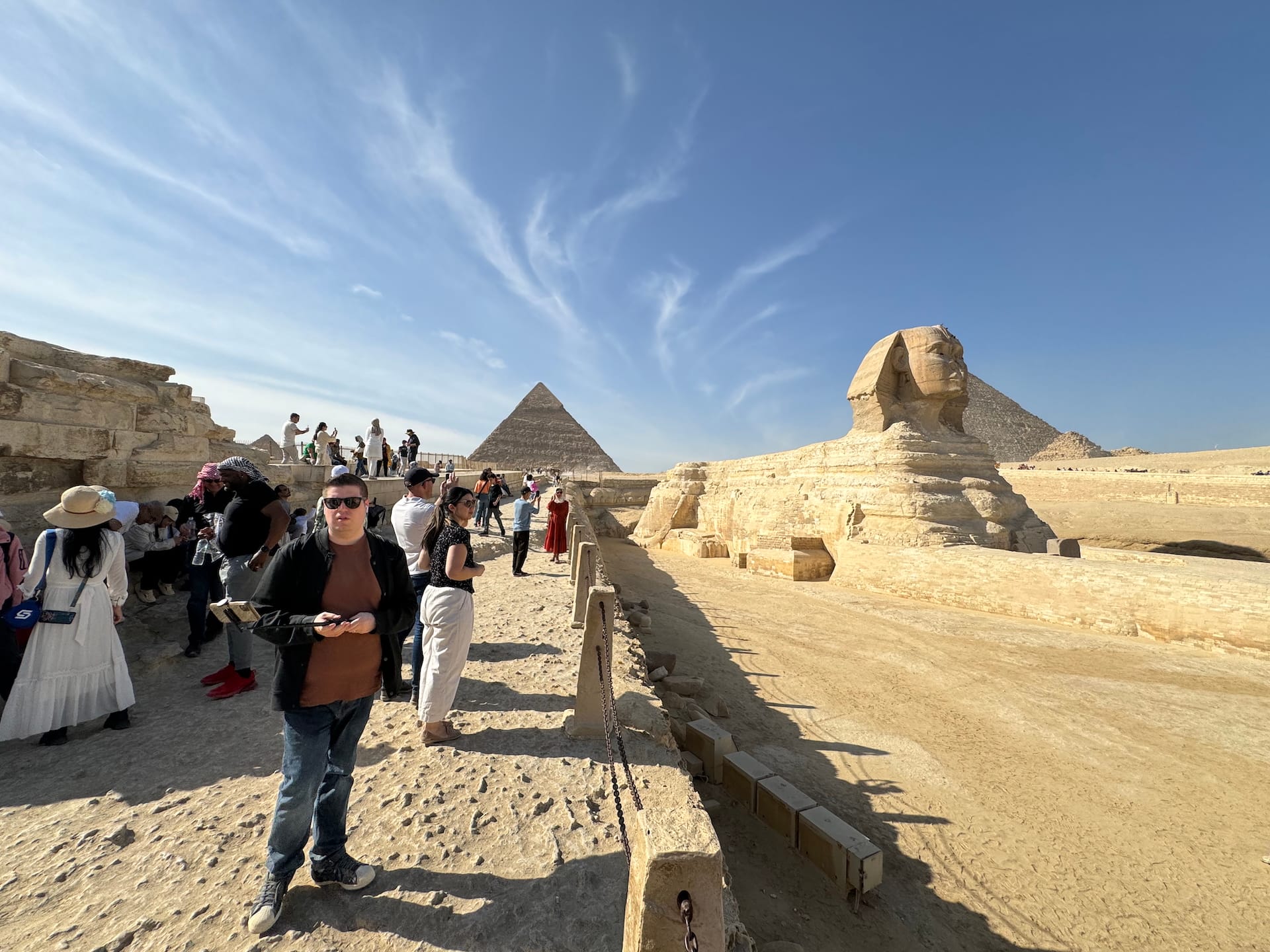
Where to Stay Near Giza Pyramids
Well, this could be a long story. What I think is very important is that before you book a hotel on an established accommodation booking portal (Booking.com, Expedia, etc.), definitely check the reviews on Google Maps or other independent platforms. Why? Because many places practice overbooking or even offer fictional rooms, then try to redirect you to another hotel (run by their “uncle”) upon arrival, which usually looks much worse than the original (if it even existed), and you lose the safety net that the booking portal would have provided because they cancel that reservation. I canceled our first booking because the hotel’s Google reviews included several that warned about this scam. I honestly can’t really recommend any particular accomodation wholeheartedly.
This was also the first time in my life I encountered the scam where they hack the hotel’s Booking account and send messages to guests in their name. In my case, it was a link through which they wanted to request a “deposit” for the reservation. I almost replied to the message saying these weren’t the terms and I’d cancel the booking, when a second message arrived where the actual hotel manager wrote quite desperately asking no one to click the link because they didn’t send it, and of course no deposit was needed. So be alert when booking accommodation in Egypt.
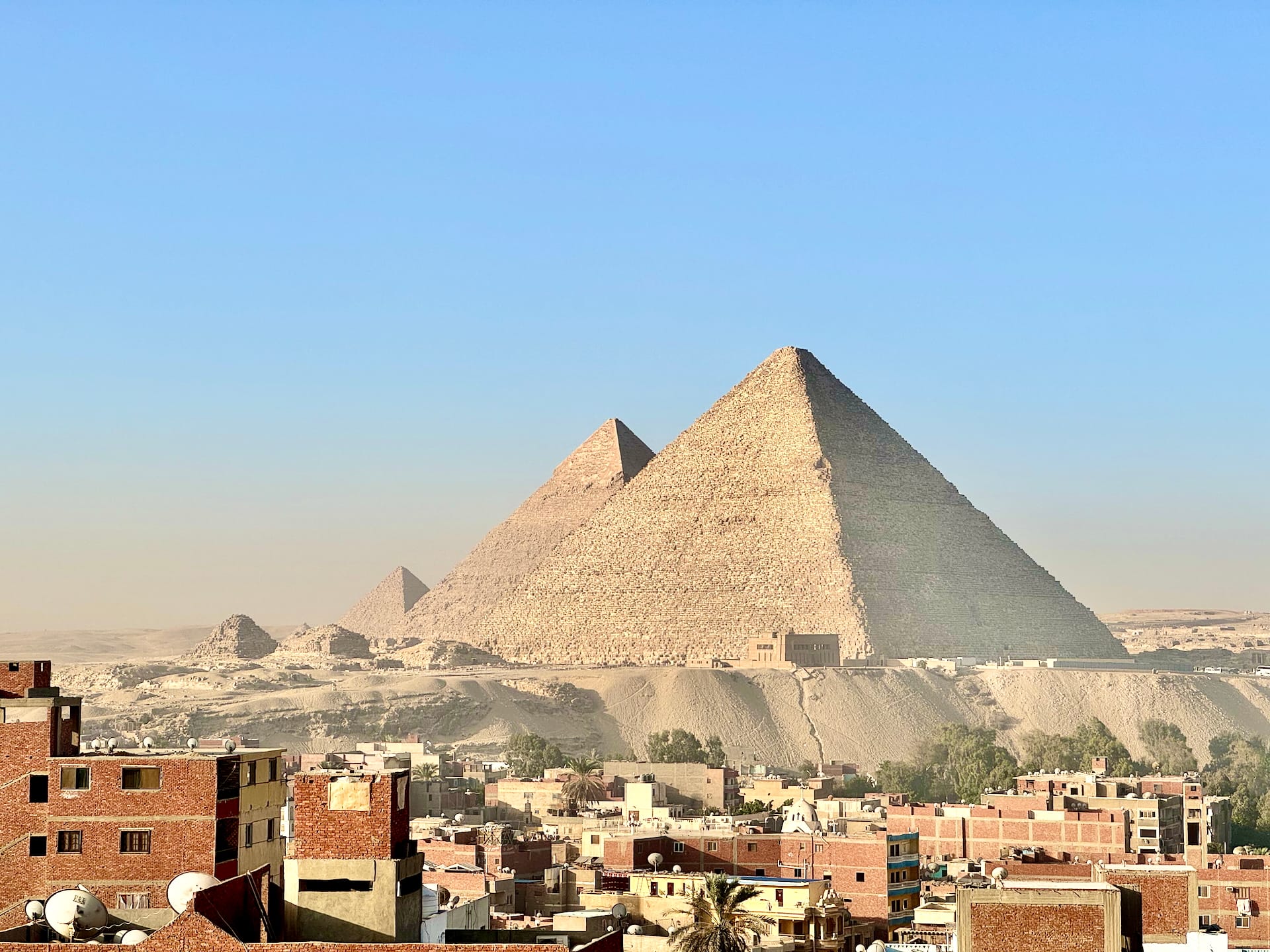
Cairo is actually a huge city, especially if you include Giza, which has completely grown together with it. Cairo proper lies on the right (eastern) bank of the Nile, while Giza is on the left (western) side. I wanted to be as close to the pyramids as possible, so I booked accommodation on the Giza side. We didn’t have any serious problems with the hotel (though the pictures were prettier…), we could see the pyramids from our window, but the real spectacular view was from the rooftop terrace at our level, where watching the sunrise was an experience by itself, and the view wasn’t bad for the breakfast served there either. So if your goal is the same as ours was, it’s worth looking around for hotels here, keeping in mind what I wrote above.
Book accommodations in Giza if you want easy access to the pyramids (there are plenty nearby). The short taxi rides save time and energy, especially important when traveling with older family members.
Egypt Currency Exchange: Official vs Unofficial Rates
Egyptian pounds (EGP) are the local currency, though US dollars are widely accepted at tourist sites. We found it convenient to have both cash and cards. The exchange rate during our visit was approximately 31 EGP to 1 USD, though current rates are around 49.6 EGP to 1 USD. Most restaurants and tour operators accept credit cards, but it’s wise to carry cash for tips and small purchases. ATMs are readily available throughout Cairo and Giza – however I never used them in the end.
What I discovered after our trip is that there’s an unofficial exchange rate that’s significantly better than the official one. As I wasn’t aware of this during our stay, I always exchanged USD at our hotel’s reception desk, which likely gave us a less favorable rate. If you’re planning a trip, it’s worth researching current exchange options and asking locals or experienced travelers about the best places to exchange money for better rates.
Complete Pyramids Tour: Giza, Saqqara, Dahshur & Memphis
We dedicated our first full day to the main program through a private tour booked via GetYourGuide. (By the way, practically all hotels also offer similar tours, so you can risk doing it without advance booking, probably getting it out somewhat cheaper.) Mom is the type who wants to see everything, so I chose a tour that included Dahshur, Saqqara, and Memphis in addition to the Giza pyramid complex. I paid 100 euros for this, which can be more or less, depending on how long the tour is (ours was 9 hours on paper) and what it includes (ours included drinks and a few snacks, but entrance fees to the sites weren’t included).
Saqqara Step Pyramid: Egypt’s Oldest Pyramid Complex
Following the early morning (7:30 AM) departure, our first stop came about 40 minutes later at the Saqqara archaeological area. Here you’ll find Pharaoh Djoser’s 197-foot (60-meter) tall step pyramid, dating from the early period, 27th century BC. We only viewed this from the outside, but we could climb down into Unas’s pyramid. Here our guide took me aside and explained there would be a man inside who would ask for a tip (baksheesh), and we shouldn’t give him more than 20 Egyptian pounds (EGP) (~$0.4 USD).
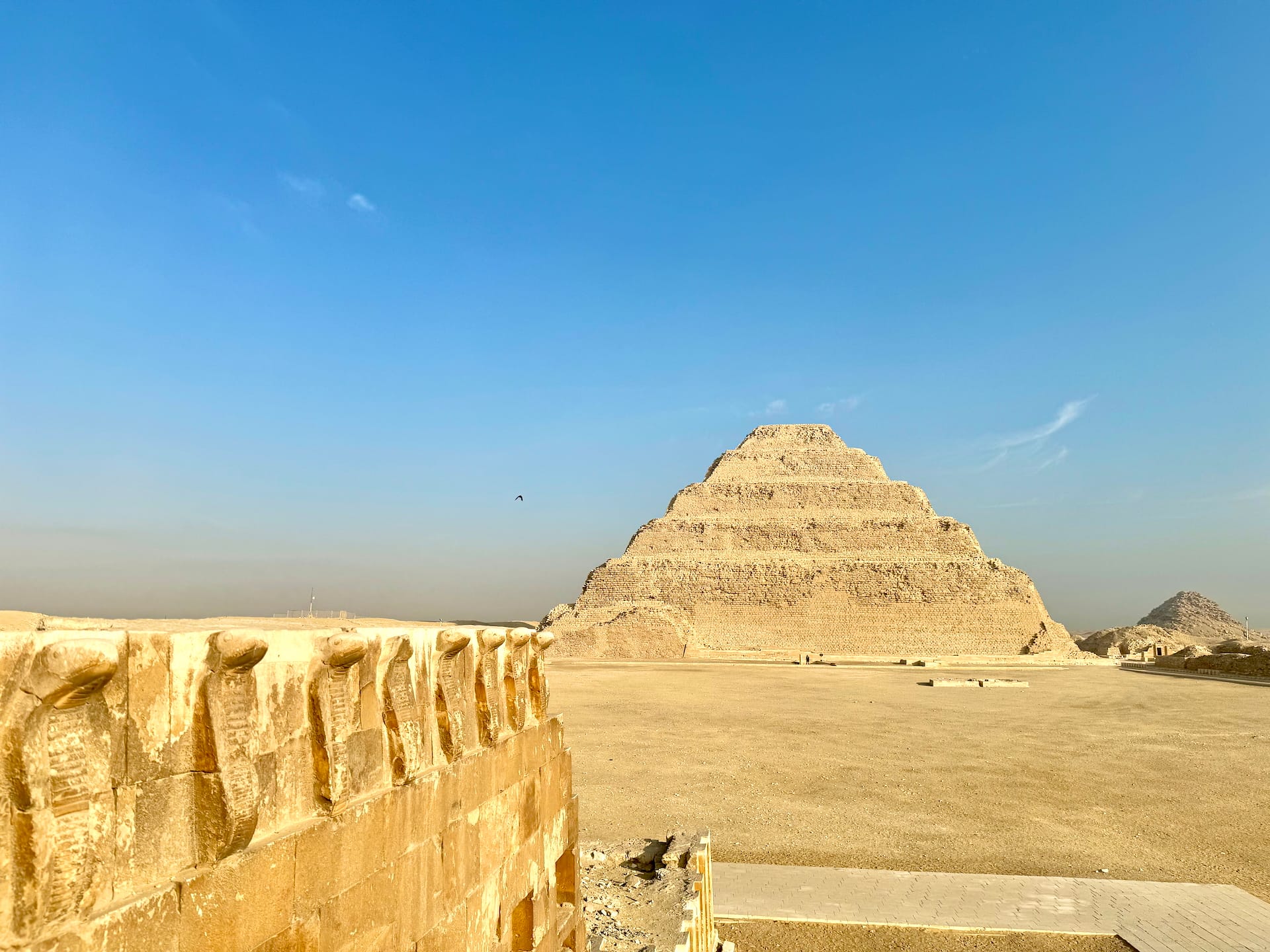
Once below, we indeed met an older man who showed us the wall paintings and reliefs in the darker areas with a flashlight, then asked if we wanted a photo of ourselves standing in the sarcophagus (the mummy isn’t there anymore). I found this quite strange, thinking they’d guard these archaeological treasures better, but it became quite clear this was standard here, so although reluctantly, I went along with it. Following a small million photos, the hand came out for payment, and since I was still very much a beginner here, instead of the originally recommended 20 EGP (~$0.4 USD), I ended up giving 100 EGP (~$2.0 USD) under the man’s urging – I didn’t make this mistake again later.
The Saqqara archaeological area is actually quite large, and we only had time for the most important things during the tight 1 hour we were there. We saw the serpent wall, the mastaba of Khnumhotep and Niankhkhnum, and one more building from inside whose name I shamefully forgot. The area itself is much larger than this, with much more to see – you could easily spend half a day here, but our guide was rushing us, so we moved on.
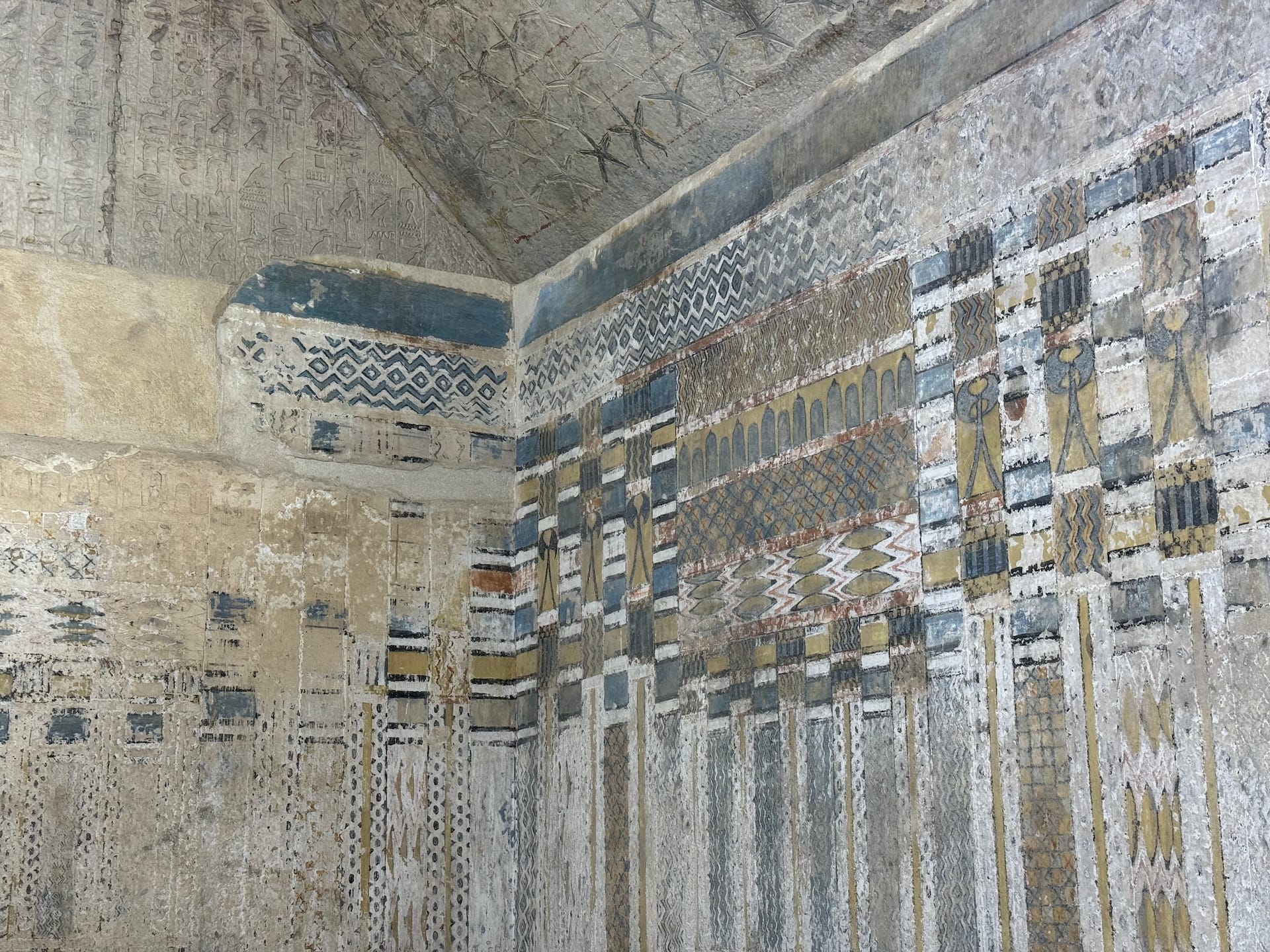
Dahshur Pyramids: Bent Pyramid and Red Pyramid Guide
Our next destination was Dahshur. This UNESCO World Heritage Site is located south of the ancient Egyptian capital Memphis and has two main attractions: the Bent Pyramid and the Red Pyramid. Both were built during King Sneferu’s reign, both for him. The Bent Pyramid is the earlier one; it was the first attempt to build a smooth-sided pyramid. The engineers of the time miscalculated things a bit, and the original 55° angle was eventually modified to 43° at just over half its height to keep the structure stable. The resulting odd-shaped pyramid didn’t win the pharaoh’s approval, so he quickly had another built next to it – this is the Red Pyramid. He didn’t lower his standards, so both are 344 feet (105 meters) tall, making these quite substantial pyramids.
The Bent Pyramid is interesting both for its shape and because you can go inside – and it’s free. (You can enter several pyramids, but usually for quite significant extra money beyond the basic entrance fee for each site.) Mom didn’t venture into this feat, but I was very curious, so I dove into the adventure. A wooden staircase leads up to the entrance, and then you descend through a very narrow passage into the pyramid’s belly underground. If you are is claustrophobic or doesn’t like tight spaces, I definitely wouldn’t recommend it, because you have to crawl on hands and knees for about 10 minutes through a passage where you can’t stand up, and even sitting is problematic in some places. I’d estimate the distance is around 80-100 meters (~300 feet).
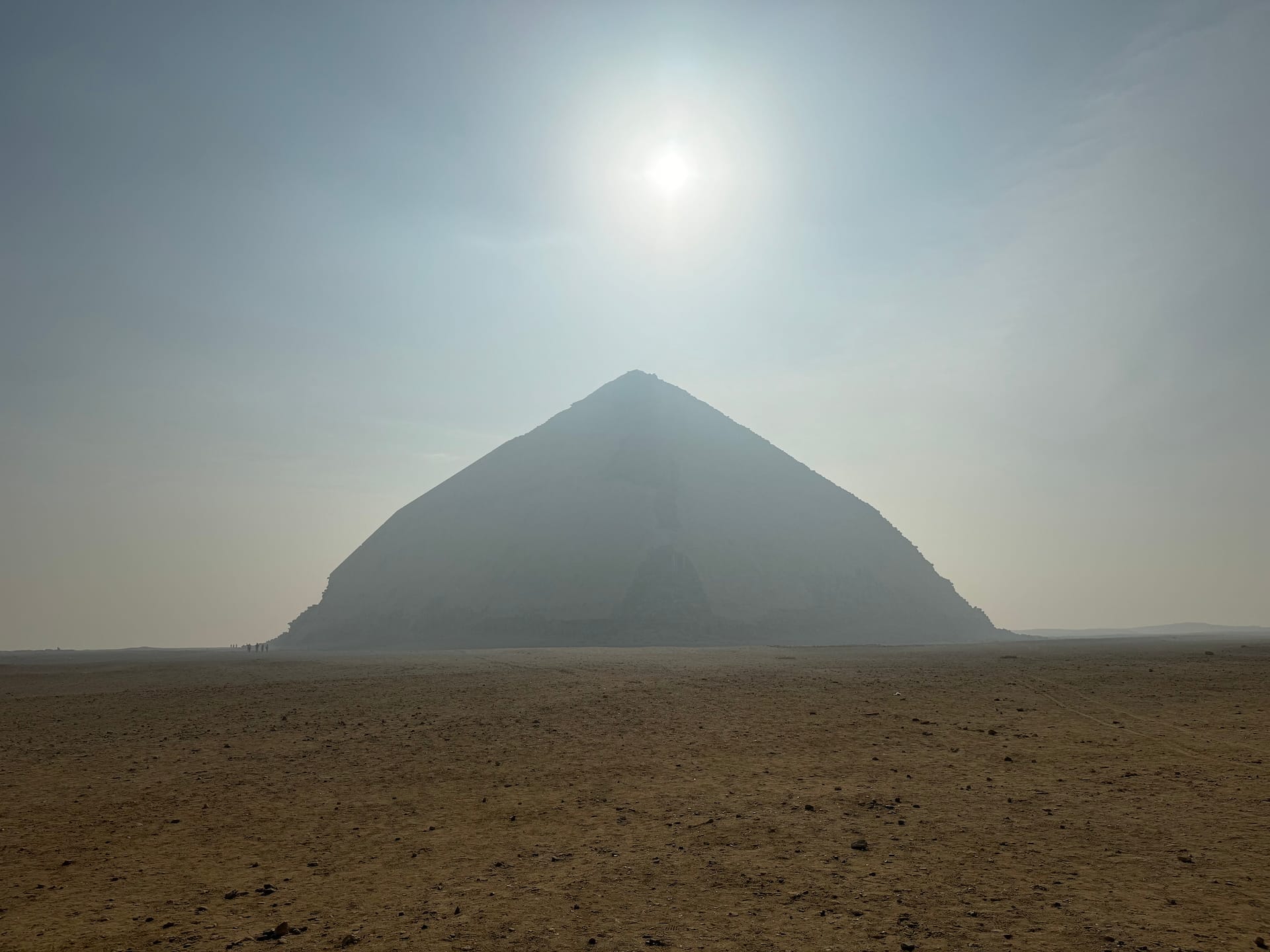
During the descent, I seriously reconsidered two or three times whether this was really a good idea, but in the end it was actually a very good experience: I was completely alone in the ancient pyramid going in, and eventually in the chamber too, which greatly added to the atmosphere. Inside, there aren’t any great excitements – you reach a large high-ceilinged room, and you can climb higher on a wooden staircase here too. There are no decorations, but the pyramid’s internal structure is interesting. I spent maybe 10 minutes down in the surprisingly warm chamber, then started back. About halfway, I met up with others who were descending. It’s not a simple feat to pass each other in the already narrow passage, so it’s worth arriving here in the morning when there might not be as many people yet, because I don’t want to think about what it’s like when crowds are trying to go up and down at the same time.
Upon reaching the surface, I politely extracted myself from the ring of local men lounging at the pyramid entrance (who expected some tip, though I didn’t exactly understand why), then set off to find my mom, who had wandered off despite our agreement to meet on the shaded side of the pyramid. I finally found her on the other side sitting on a bench in the company of a local man, who explained he had watched over her and therefore deserved a small tip – I got rid of him by saying my wallet was in the car.
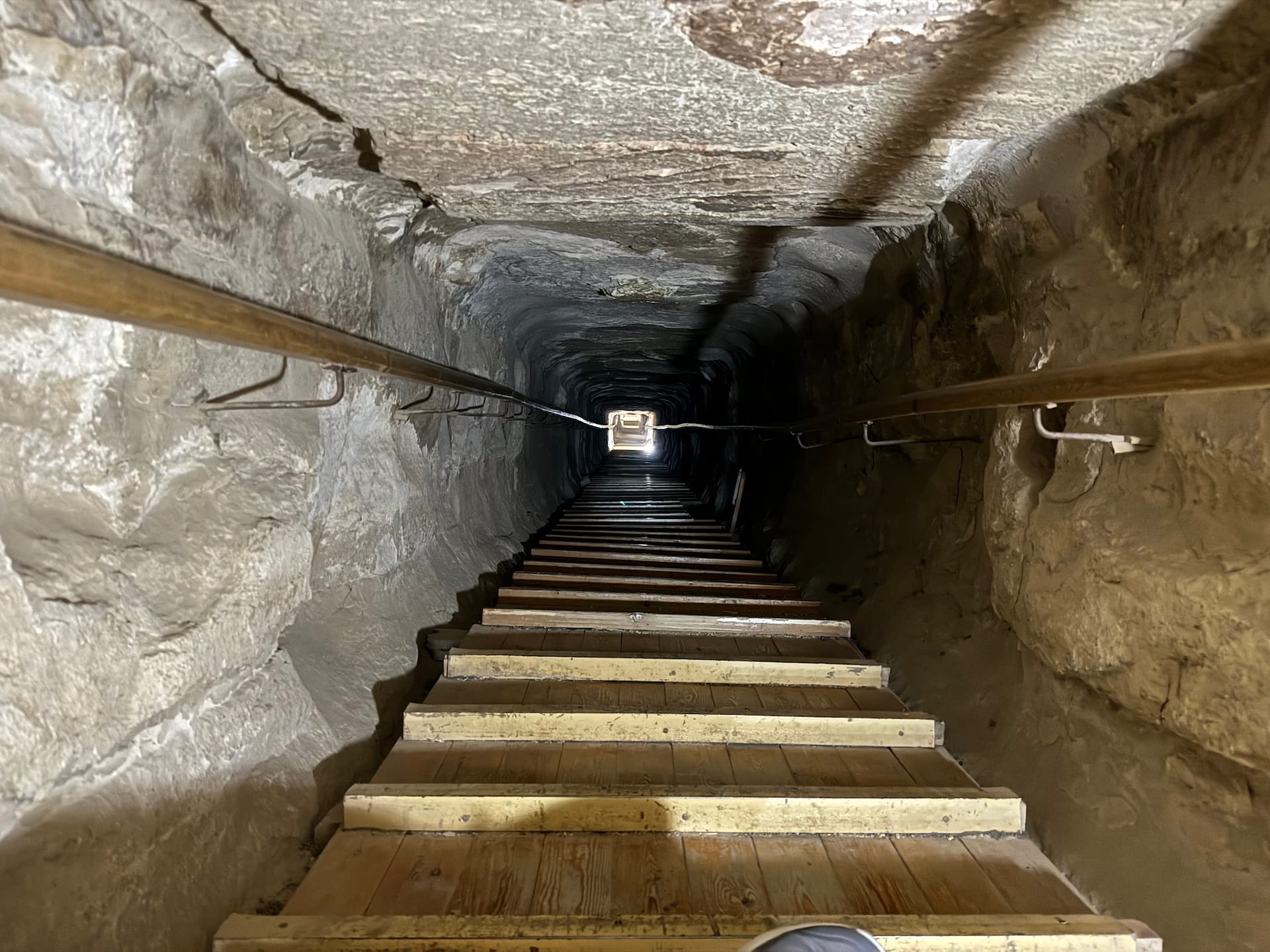
Following this, we briefly viewed – only from outside – the Red Pyramid, and concluded the altogether tight one-hour stop before driving to the next station.
If you plan to enter any pyramids, wear comfortable clothes and be prepared for tight spaces. Bring a small flashlight or use your phone’s light to better see the interior details.
Memphis Ancient Capital: Ramesses II Statue Museum
The Memphis part of the tour actually means the Mit Rahina open-air museum, where you can view the massive statue of Ramesses II and other archaeological finds. The statue itself lies in a building, in surprisingly good condition – considering it’s more than 3,000 years old, it doesn’t look a minute older than a few hundred years. Every detail remains crisp: the intricate pleating of his ceremonial kilt, the delicate carving of his fingernails, even the subtle smile playing at the corners of his mouth. When Italian explorer Giovanni Caviglia discovered it in 1820, the statue was too massive to move, so they built the museum around it – a decision that now allows visitors to view it from both ground level and a raised walkway above.
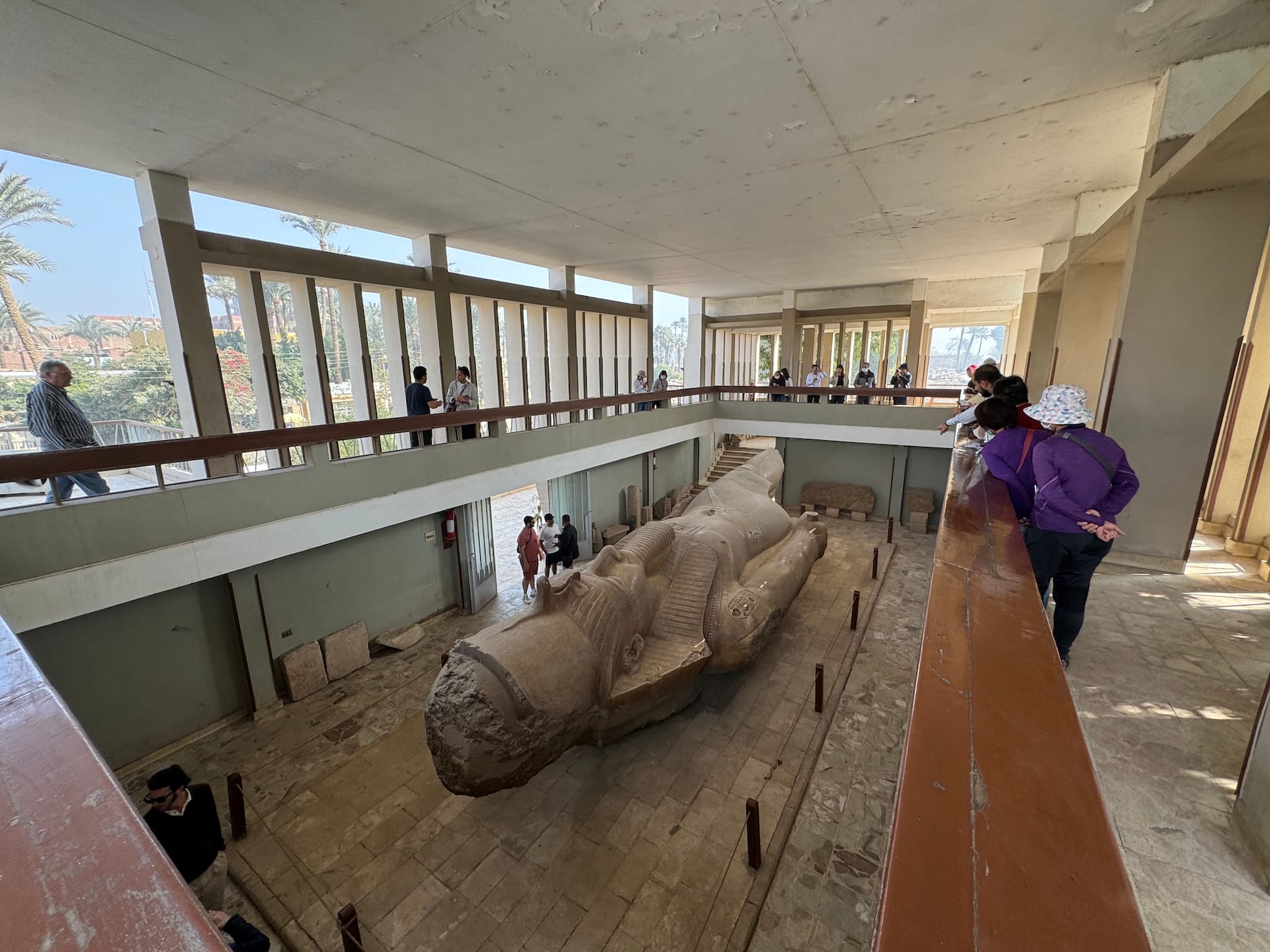
What makes this statue extraordinary isn’t just its preservation, but its artistry. From the elevated viewing platform, you can appreciate details invisible from below: hieroglyphic inscriptions that run along his belt, the careful attention paid to anatomical accuracy, and the way ancient sculptors captured both power and serenity in stone. Our guide explained that this wasn’t just art – it was propaganda, designed to project Ramesses II’s divine authority across his vast empire.
The outdoor courtyard houses additional treasures, including an alabaster sphinx and various stelae, but they pale in comparison to the main attraction. This became our impromptu classroom as our guide demonstrated how to read basic hieroglyphs using inscriptions on nearby monuments.
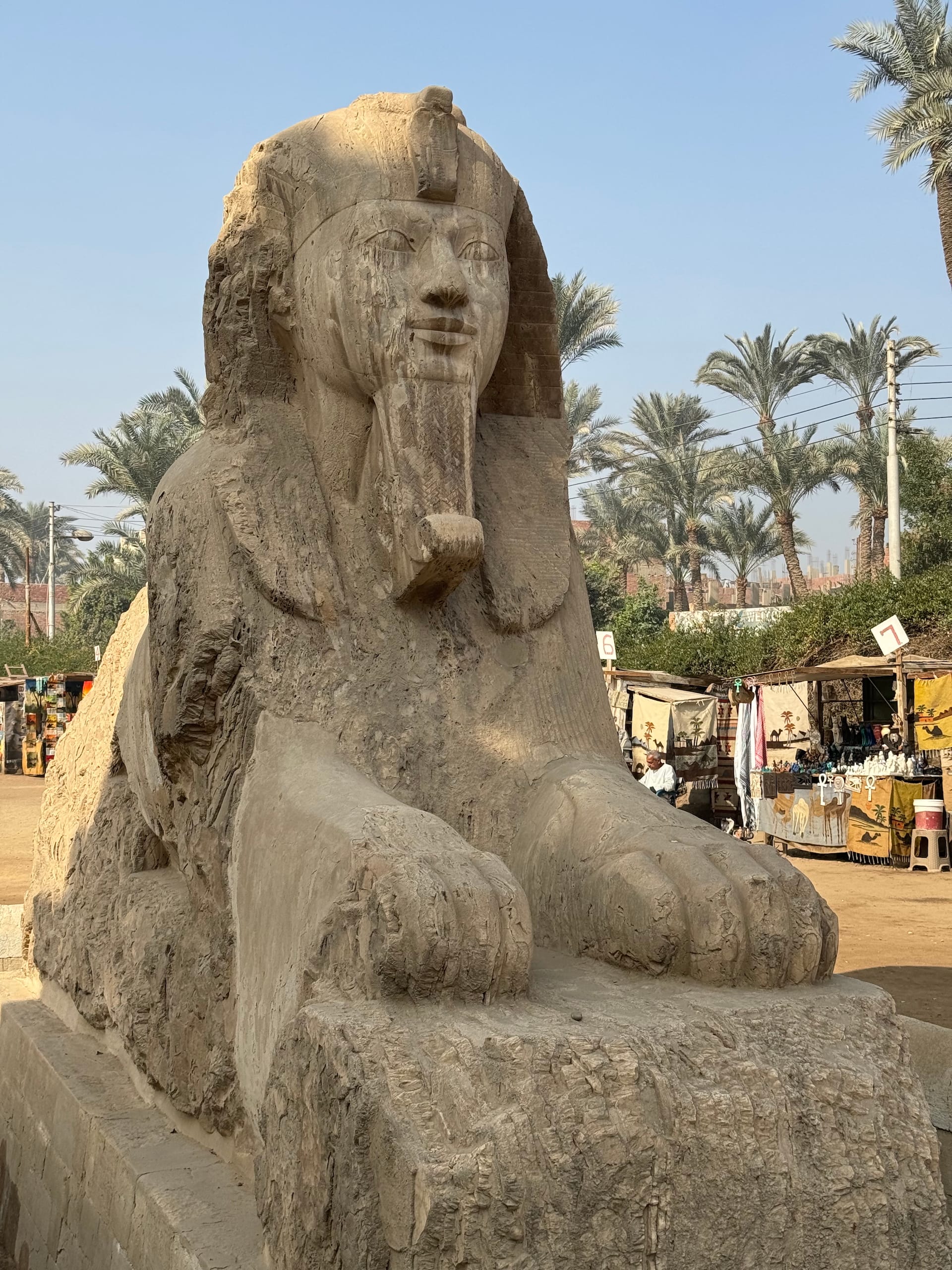
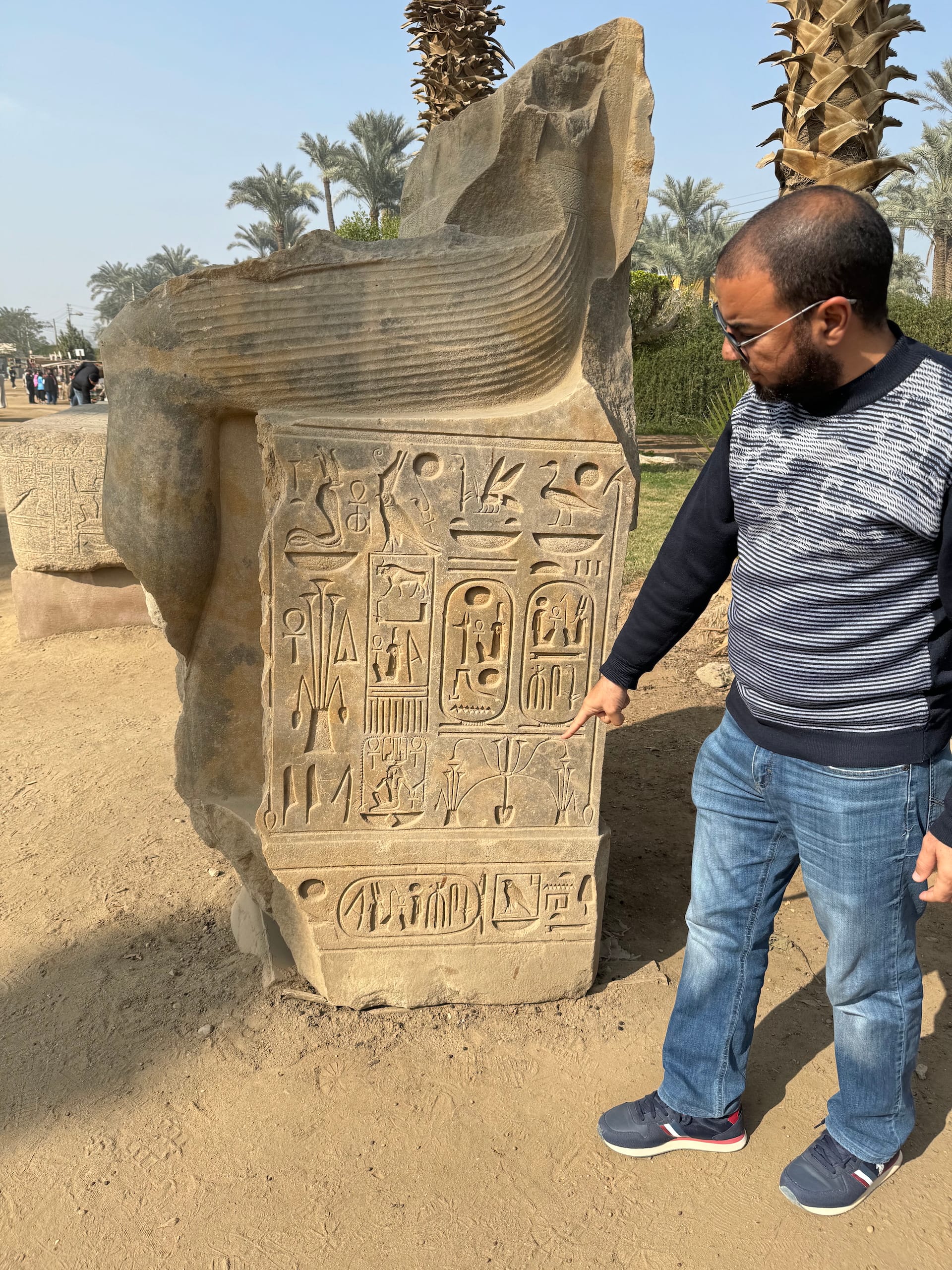
The inevitable vendor encounters began here too. Several merchants, whom our guide knew personally (and who were, coincidentally, the finest craftsmen in all of Egypt), offered their wares with practiced enthusiasm. I succumbed to purchasing a small “alabaster” cat statue as a birthday memento for mom, watching our guide negotiate the price down from astronomical to merely expensive. Whether it’s genuine alabaster remains questionable, but it serves as a perfect reminder of Egyptian hospitality – and tourist economics.
Great Pyramids of Giza and Sphinx
Following the roughly half-hour stop in Memphis, the day’s highlight finally arrived: viewing the Great Pyramids of Giza – Khufu, Khafre, and Menkaure’s pyramids. Though I’m not sure whether this is really the highlight, but I am sure it’s by far the most famous and popular stop of all. We reached the site entrance just past noon, the guide fought his way through the huge line, bought the tickets, and we could head inside.
The crowd here is much larger, and to be honest, the pyramids aren’t as spectacular up close as they are from a bit farther away, although it’s mind-blowing to see how large stones they managed to stack on each other thousands of years ago. We examined the pyramid closest to the entrance, Khufu’s (Cheops) pyramid, more closely. Originally 481 feet (146.5 meters) tall, the pyramid has now worn down to 449 feet (137 meters) (lost/had its smooth outer covering removed), but it was the world’s tallest structure for 3,800 years. You can enter the pyramid for a hefty extra fee, but from what I read, it’s not particularly recommended because there are usually huge crowds and it’s not that spectacular, so we skipped it. (Nothing could top the experience of time spent alone in the Bent Pyramid anyway.)
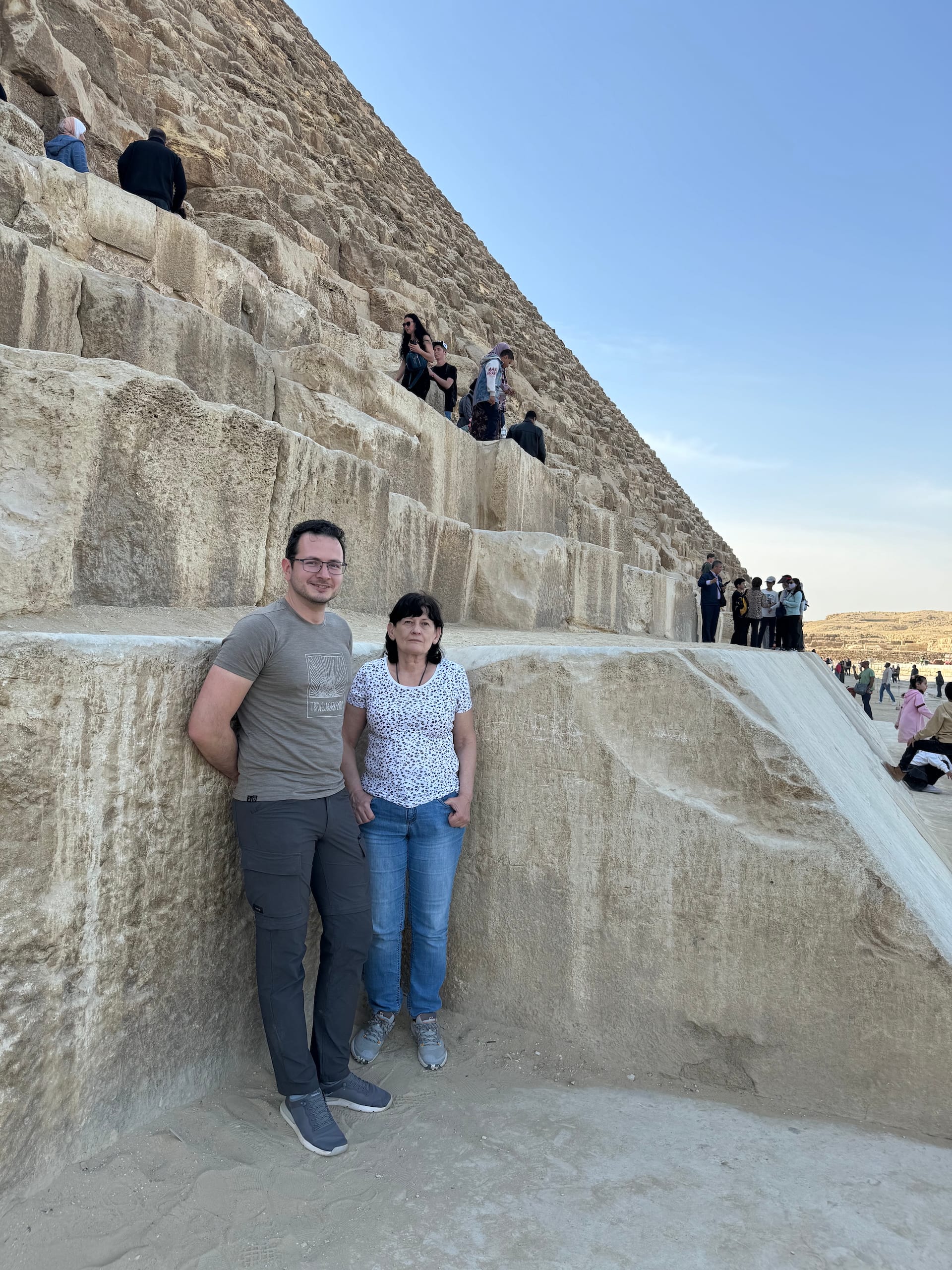
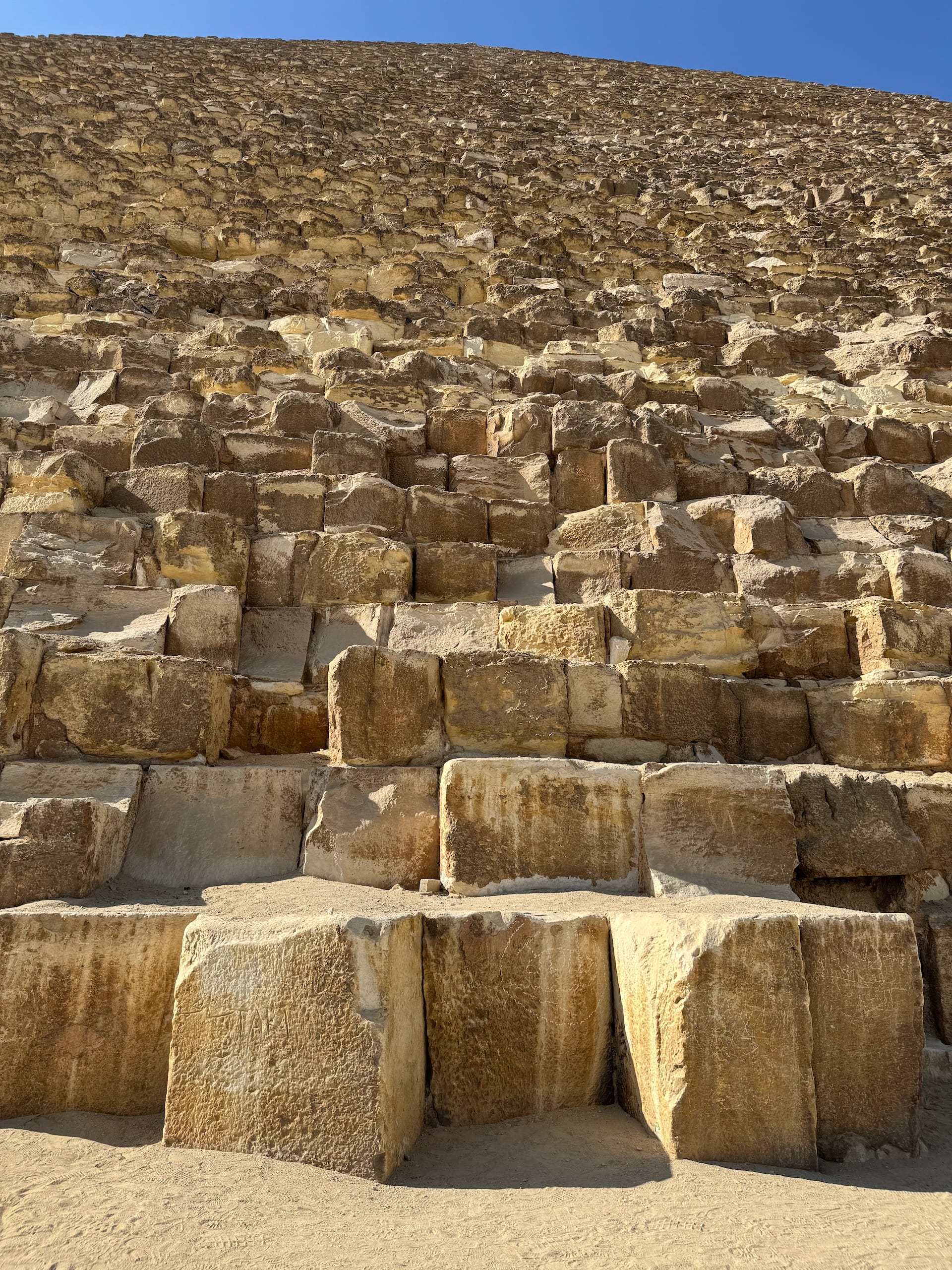
Around the great pyramid, there’s much more to see: there’s a small pyramid, three queens’ pyramids, boat pits, the workers’ city, and more – unfortunately, our guide told us practically nothing about these, and didn’t even come with us when we half-circled the pyramid, as he visibly wanted to go home already. It’s worth watching where you step; the ground isn’t the smoothest, and I almost sprained my previously broken ankle, which would have been quite unpleasant. It’s important that you’re not allowed to climb the pyramid, except that if you go inside, when you have to go up to the entrance. You can ride camels and buy all sorts of things in the area, but we skipped these.
Following the great pyramid, we drove a bit further to a point where you can better see the entire area and all three great pyramids. However, you can’t take the iconic photo (the three great pyramids with the small pyramids) from here, as I discovered, but from much farther away, from a different angle, with a telephoto lens.
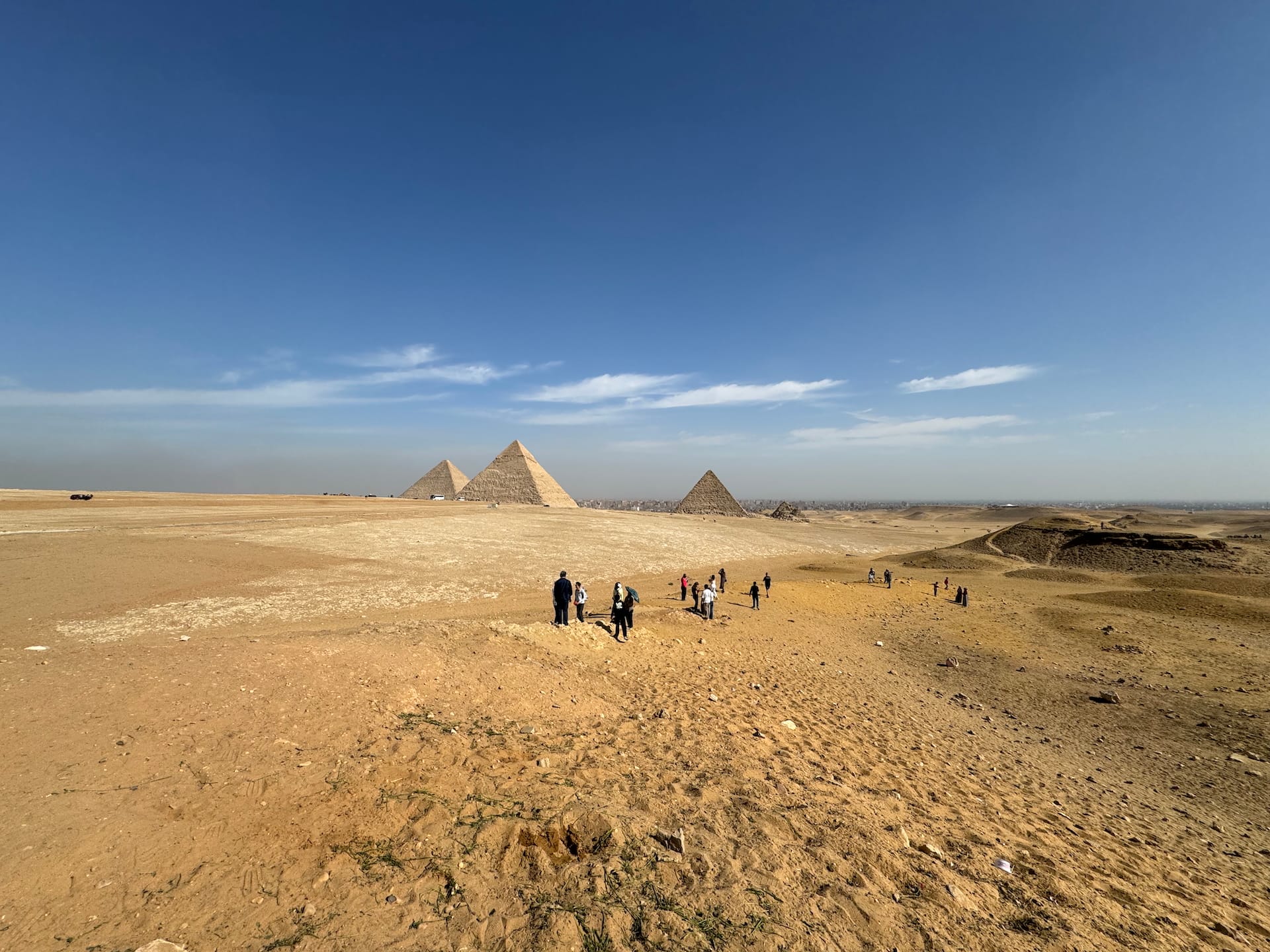
One thing remained: the sphinx. The world-famous massive sculpture was carved directly from rock found on the site during Khafre’s (Khufu’s grandson) reign. From what I’ve read since, there’s quite contradictory information about how you can visit it. The official website states “private visits only,” which I don’t know what that could mean, because while we couldn’t get right next to it, we could see it from quite close up.
Viewing the sphinx was the conclusion of that day’s excursion, and from here the guide and driver took us back to our hotel. The tour wasn’t bad overall, but I would have preferred a more enthusiastic guide who explained everything in much more detail – especially at the last stop. He visibly took things quite hastily; instead of the promised 9 hours, it ended up being about 7 hours, though maybe they count the 9 hours including if you have to fight through traffic jams in Cairo (we stayed practically right next to the pyramids). I wouldn’t recommend this specific tour (though it has since disappeared from GetYourGuide), but I’d definitely recommend a well-reviewed similar private tour. You can see the most important sights in one day at this pace, but if you’re really curious about everything, you could easily spend a total of 2-3 days at the sites.
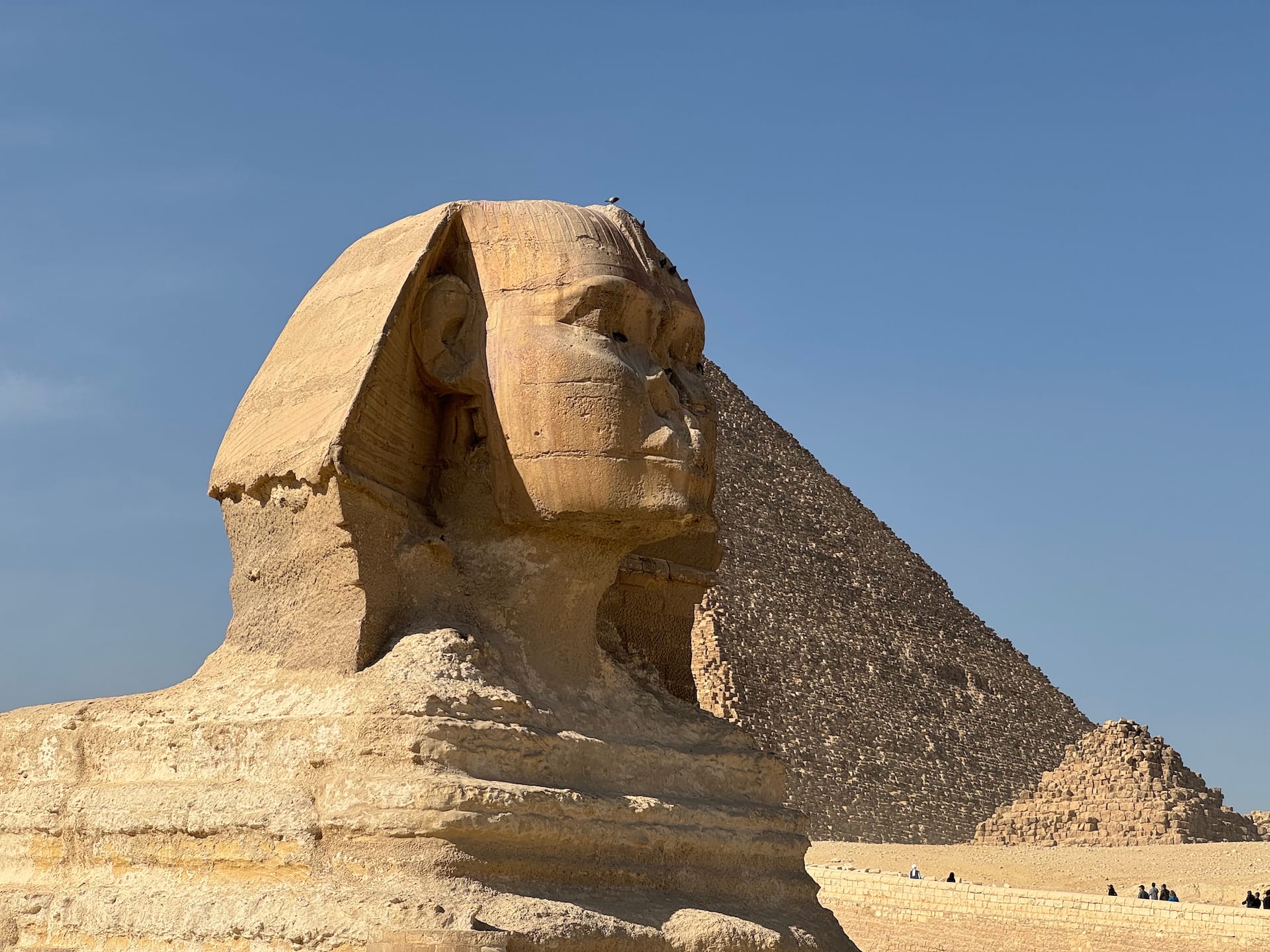
Top Cairo Attractions Beyond the Pyramids
Of course since we were there, we didn’t just visit the pyramids but a few other attractions as well. We basically had three full days, which I divided so that on the second day we saw Cairo’s main sights during another private tour and then the new Grand Egyptian Museum. The third day was entirely a museum day, with the Egyptian Museum and the National Museum of Egyptian Civilization. I’ll briefly report on these as well.
Islamic and Coptic Cairo Tour
For viewing old Cairo’s attractions, I also booked a private tour for around $125 USD (for two). Unlike the pyramid one, I would highly recommend this one. Esraa, our guide, was very kind, didn’t rush at all like the guy the previous day, and explained all the important information about each location. She even recommended a great restaurant that we tried the next day.
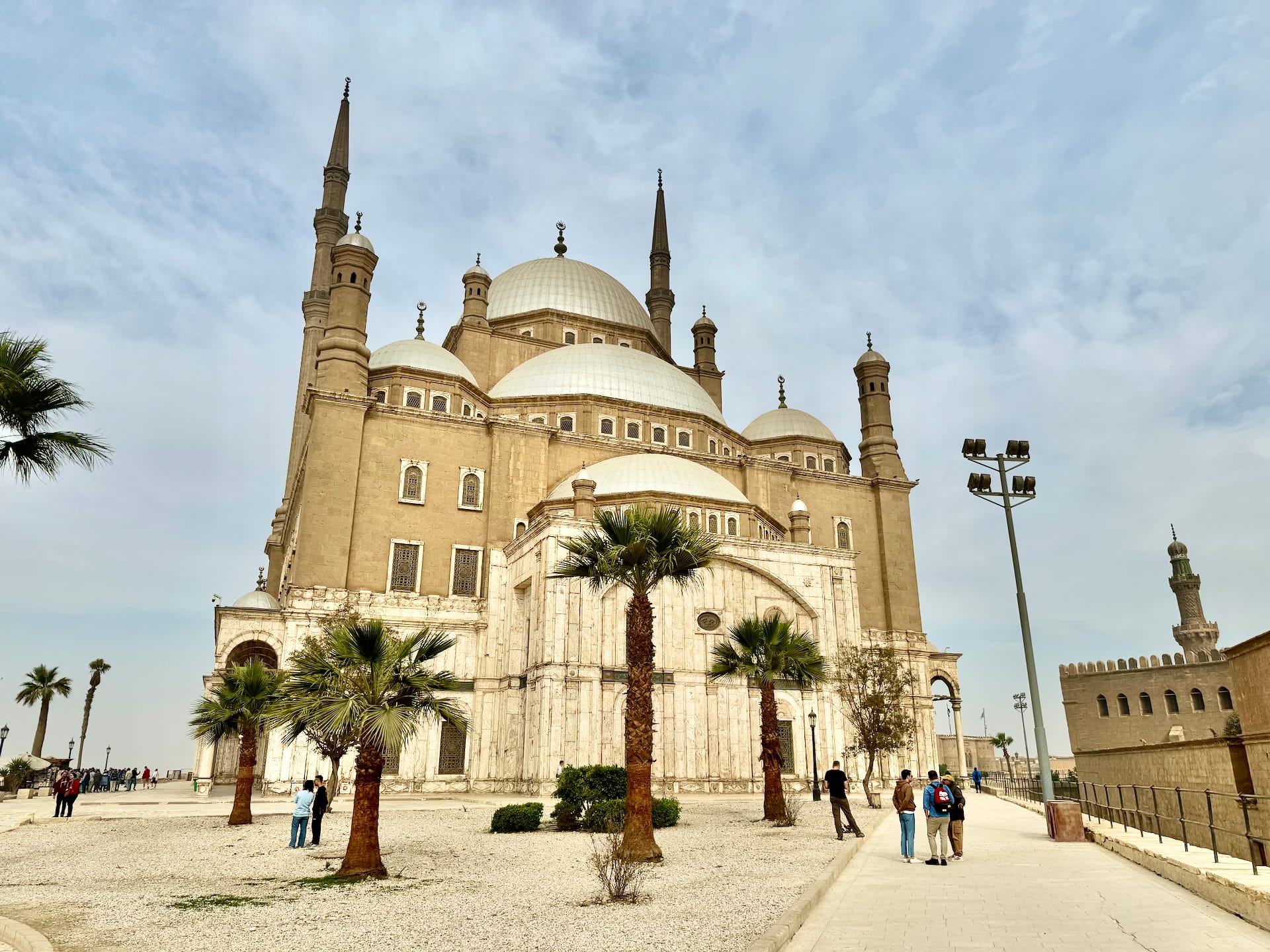
The driver picked us up at the hotel, then the tour’s first stop was the Cairo Citadel and the impressive Mosque of Muhammad Ali. From there we went to the Khan el-Khalili bazaar. Bazaars aren’t my favorites, but with Esraa’s guidance, it was much more exciting. She showed us her favorite vendors, she even shopped (surprisingly, gummy candy!), and we bought various nuts (pistachios, cashews). Unlike usual, we didn’t have to visit any uncle’s or brother’s shop, and we spent exactly as much time in the market as we wanted.
Next came Cairo’s Coptic quarter. We toured the unmissable Hanging Church, which the guide told us about in great detail. We only saw the Roman tower from outside, but we went into Saints Sergius and Bacchus Church, and since we were interested, we also visited the Ben Ezra Synagogue. The area also had a hearty lunch at a restaurant featuring typical local dishes (food is included in the tour price, but if you drink anything other than water, you pay extra for that). Including travel, it was somewhere between 5 and 6 hours total, so we could still see something else in the afternoon.
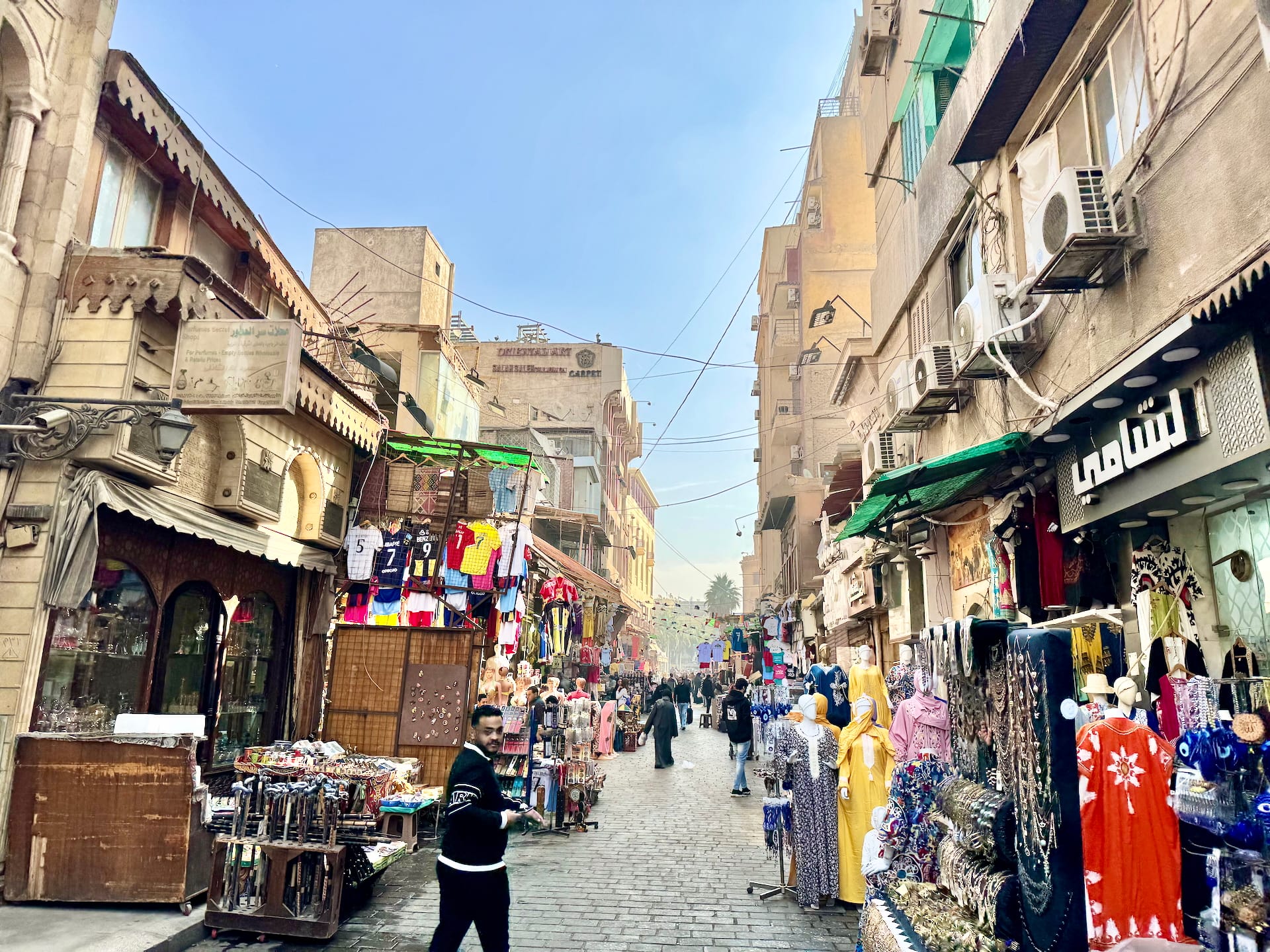
Grand Egyptian Museum: The New Giza Museum
This something else was the Grand Egyptian Museum. The troubled project (its opening was continuously delayed by years, and they started building it more than 10 years ago) wasn’t fully open when we were there in early 2024. (At that time, they were promising a grand opening for mid-2024. The current target date is July 3, 2025 the final quarter of 2025…) I basically wanted to see it from outside for its architecture, but it turned out you can’t really approach it without a ticket – at least the security guards wouldn’t let us in – so I quickly bought two special tickets online that included a 360° short movie about Tutankhamun and a guided tour, for 1,200 EGP (~$24.2 USD) per person. During the guided tour, you could walk through the main hall and the grand staircase. Currently (June 2025), they sell two types of tickets: the simple entry costs 1,270 EGP (~$25.6 USD) per person, and the guided tour is 1,700 EGP (~$34.3 USD), the latter also available in English. Fortunately, they’ve now opened 12 additional exhibition rooms beyond the parts we saw.
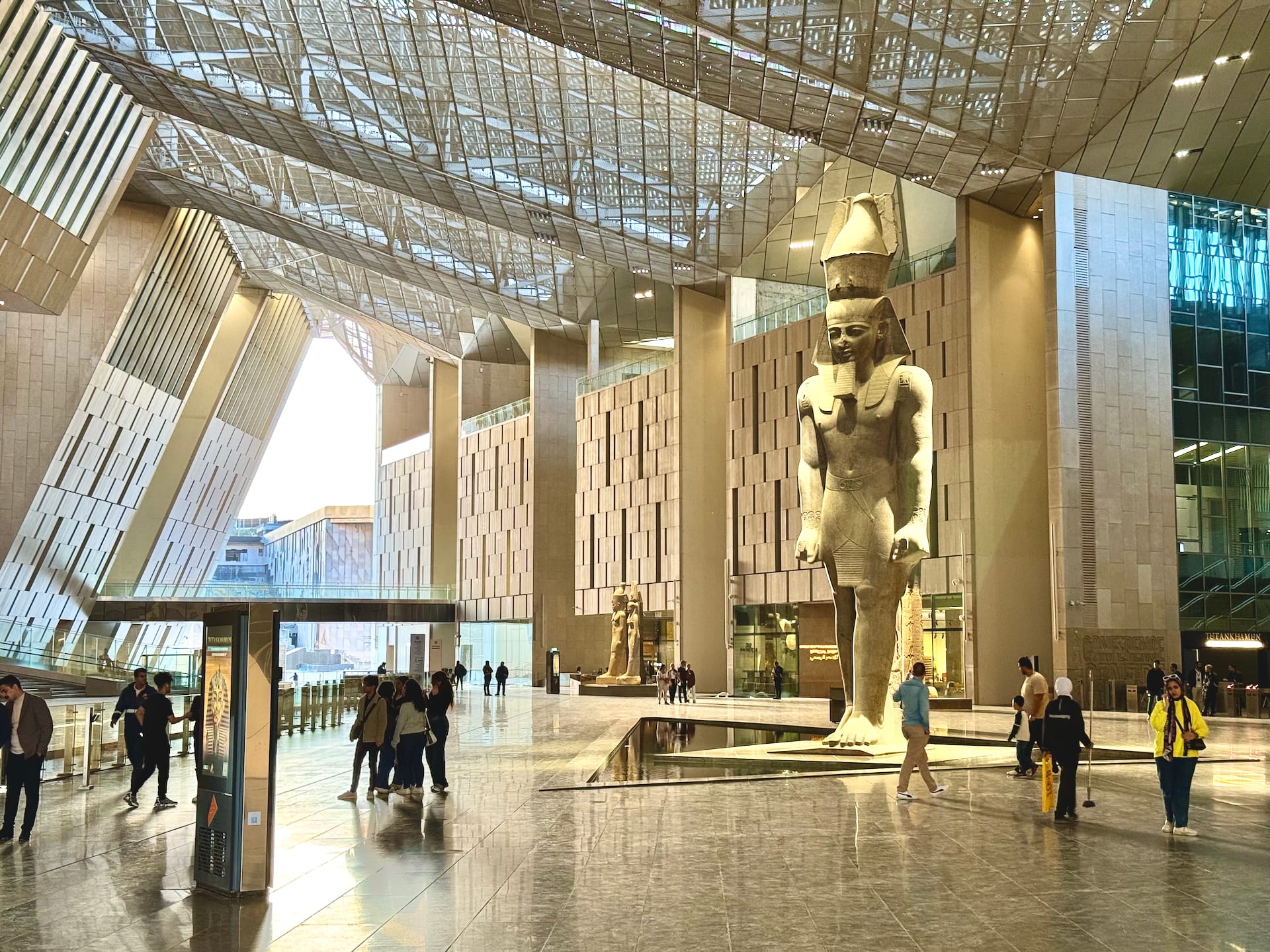
The museum building was very impressive: there are huge spaces in it, and I particularly liked it architecturally, especially such details as the holes in the facade through which the sun shines on a precisely determined spot twice a year. There weren’t many artifacts in it yet, but they had already moved Ramesses II’s massive statue when we were there (okay, I’ll spoil the surprise: this is what the sun illuminates on February 21 and October 21, on his birthday and coronation day), and there were quite a few statues, sarcophagi, and other items along the stairs. Over time, according to plans, the most significant treasures (more than 100,000 pieces) will be moved here, as well as a more detailed Tutankhamun exhibition than ever before, but when that will happen is a good question. With its 80,000 square meters (~860,000 square feet) of floor space, this is the world’s largest archaeological museum.
Book Grand Egyptian Museum tickets online in advance, especially during peak tourist season. The museum offers audio guides in multiple languages to enhance your visit.
Egyptian Museum Cairo: Tutankhamun Treasures and Artifacts
Finally, we dedicated a full day to two museums. We planned to arrive relatively early at Cairo’s main museum for now, the Egyptian Museum. We ended up with a huge traffic jam in the city, and the journey there was about 1 hour longer than we calculated. The museum building located in the northern part of Tahrir Square has seen better days, but the treasures found here compensate for the environment.
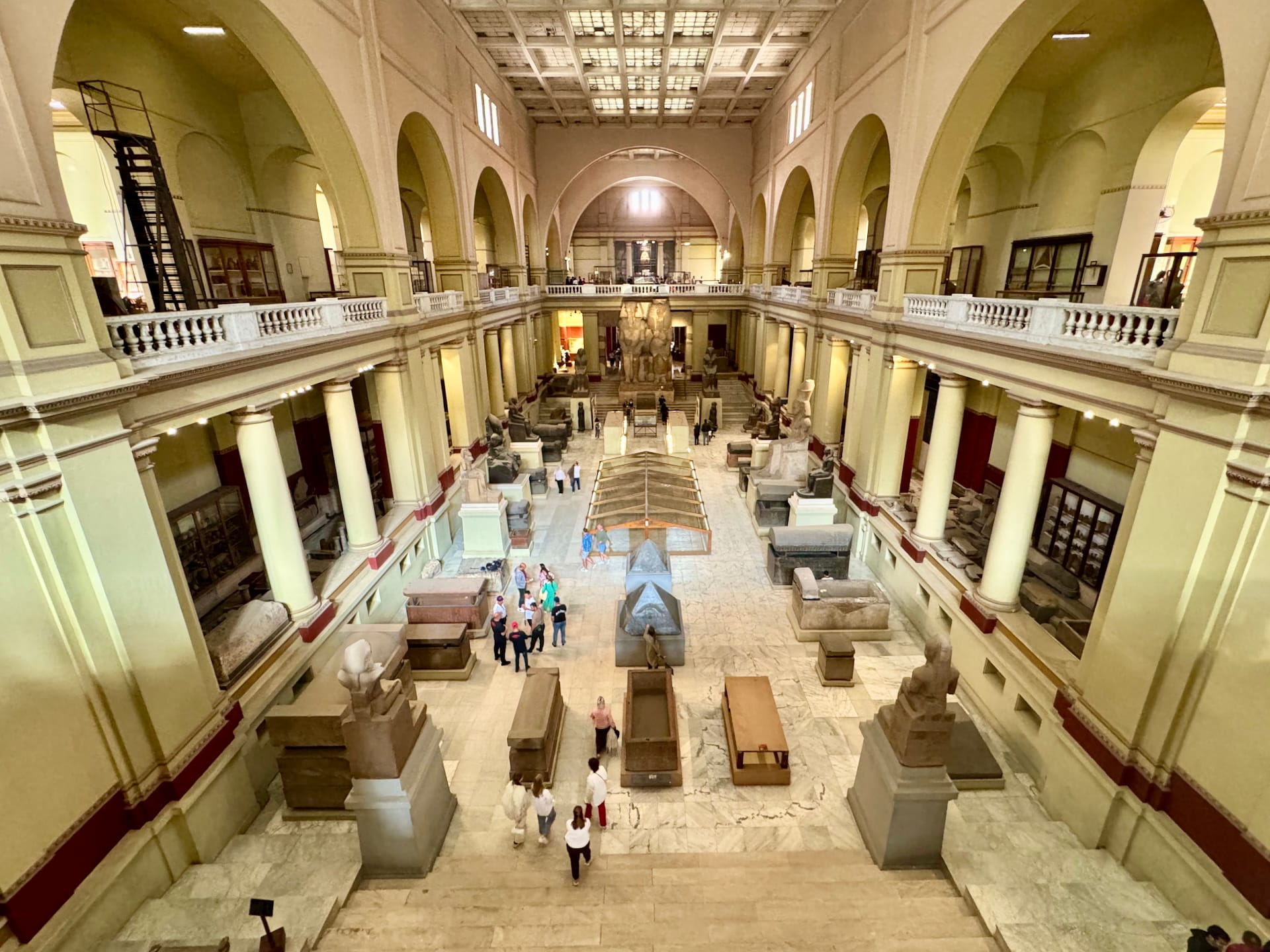
The exhibitions are grouped according to ancient Egyptian historical periods, and you can encounter many different types of attractions. Perhaps the most famous is the New Kingdom Period collection, as Tutankhamun’s treasures are part of this, with the famous death mask alongside other excellently preserved objects – seeing the mask in person reveals intricate details no photograph captures (and most certainly you won’t photograph those too, as taking pictures is prohibited here). There are quite a few mummies in this museum too, but we saved the main mummy viewing for the next museum.
We spent about 3 hours here, then went to lunch at the restaurant recommended by Esraa the day before, Koshary Abou Tarek. This restaurant serves only one dish, koshary, which is basically Egypt’s national dish. Imagine a pasta salad-type thing with chickpeas, lentils, tomato sauce, and fried onions. It’s incredibly delicious, a perfect comfort food.
The Mummyseum: National Museum of Egyptian Civilization
We went to that day’s second museum specifically for the mummies. We planned several hours for this too, but it turned out there’s nowhere near as much to see here as in the Egyptian Museum. In the large atrium at ground level, there are also artifacts arranged more or less chronologically. However you can instantly see that this isn’t the main attraction, but rather the most important mummies that were moved here from the Egyptian Museum in 2017.
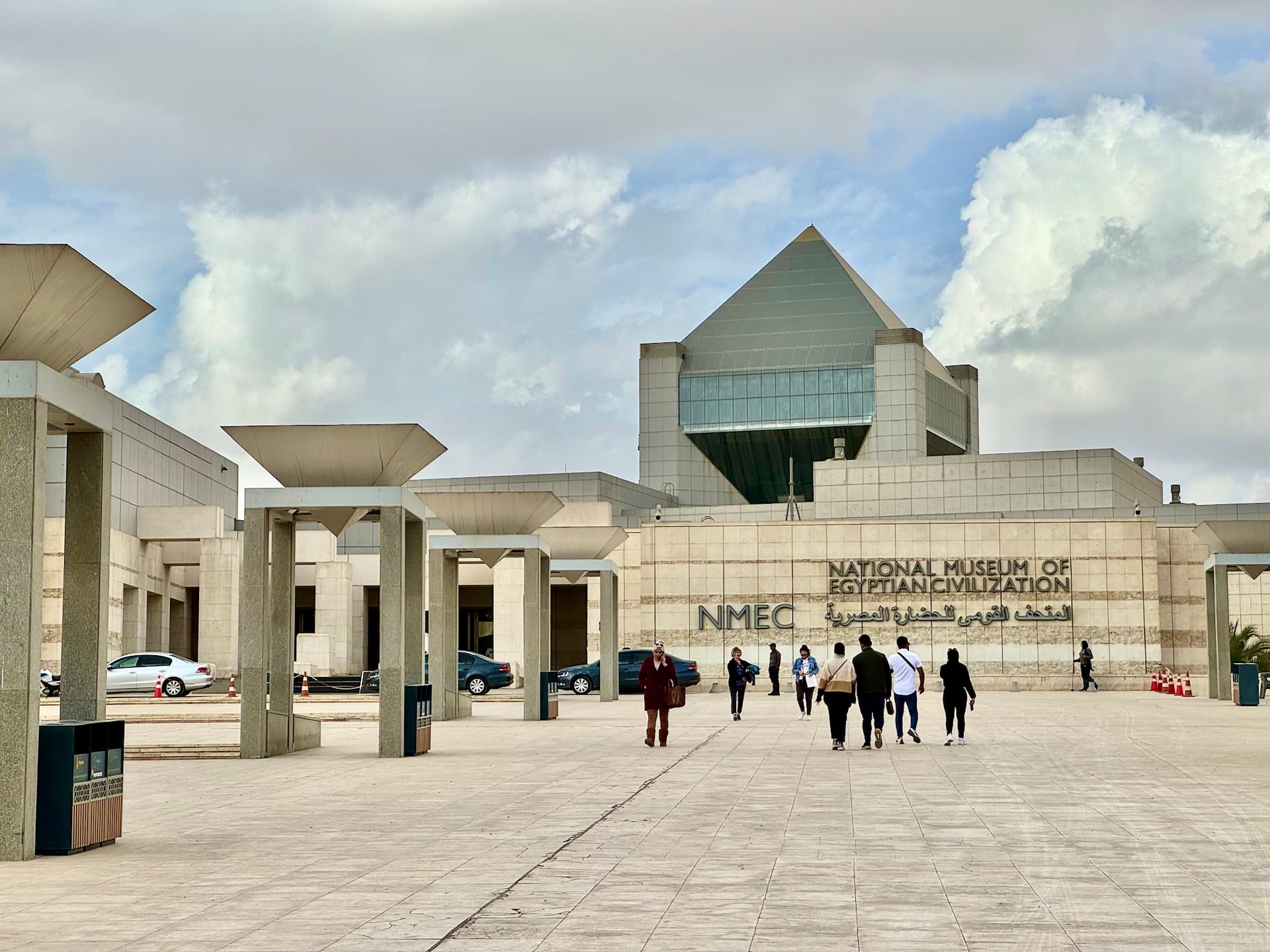
The Royal Mummies Hall delivered an experience unlike any other museum visit. Walking through the dimly lit, climate-controlled chambers, we came face-to-face with actual pharaohs – not replicas or artifacts, but the preserved bodies of rulers who shaped ancient history. The standout moment was seeing Ramesses II, and most of the mummies are so well-preserved you can still see their hair and facial features clearly. Equally fascinating was Queen Hatshepsut, one of Egypt’s few female pharaohs, whose mummy was only recently identified in 2007. The museum’s brilliant design makes you feel like you’re walking through actual tomb chambers, complete with the reverent silence that naturally falls over visitors.
Egypt Tourist Attractions: Ticket Prices 2025
When it comes to entrance fees, the situation is sometimes a bit confusing because in many cases (primarily at larger, outdoor attractions), you need to buy several tickets during one visit if you want to see everything and go inside everywhere (most of the pyramids, for example, require separate tickets). The Egyptian Ministry of Tourism and Antiquities website has all the different attractions and ticket prices very well compiled (if it’s not loading, it’s worth checking back later or refreshing once or twice), and I also found a table that seems up to date.
Prices differ depending on whether someone is a local resident or foreigner; for foreigners, a ticket can cost 10x-20x more. We paid the following entrance fees (each per person – updated in 2025!):
- Saqqara Area: 600 EGP (~$12 USD)
- Dahshur: 200 EGP (~$4 USD)
- Mit Rahina Museum (Memphis): 200 EGP (~$4 USD)
- Giza Necropolis (Great Pyramids): 700 EGP (~$14 USD)
- Salah al-Din al-Ayyubi Citadel: 550 EGP (~$11 USD)
- Grand Egyptian Museum (guided tour): 1,700 EGP (~$34 USD)
- The Egyptian Museum: 550 EGP (~$11 USD)
- National Museum of Egyptian Civilization: 500 EGP (~$10 USD)
- Total: approximately 5,000 EGP (~$100 USD) per person
Where there’s parking at outdoor attractions, you usually have to pay for parking in theory, but this was included in the private tour prices (if the drivers actually paid at all).
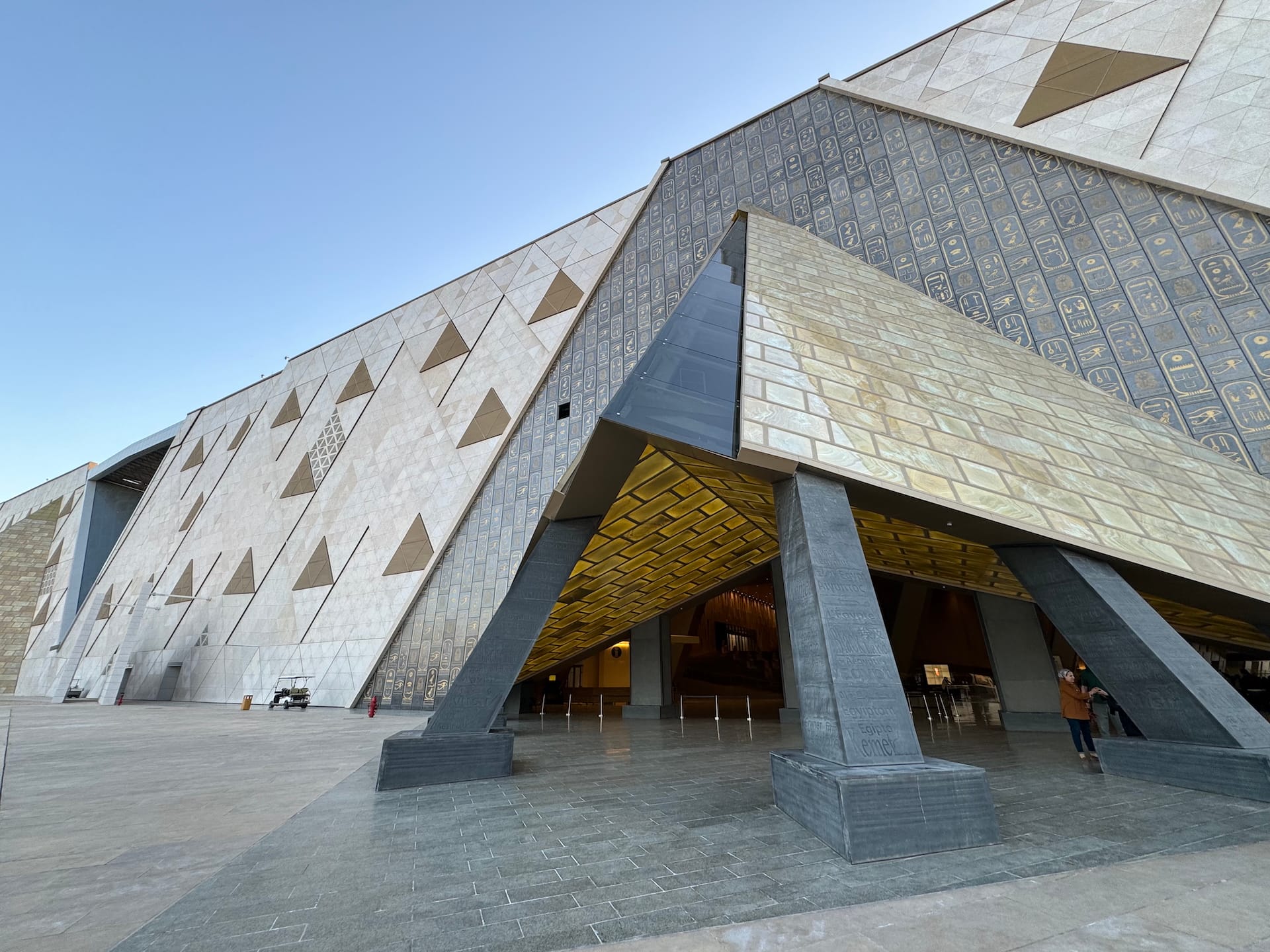
Egypt Travel Safety: Avoiding Scams and Tourist Traps
Since I wasn’t traveling alone or with one of my usual companions, but with my 75-year-old mom, I tried to prepare in advance for every possibility, researching the most common scams and tricks we might encounter during our trip. After some searching, I was almost as paranoid as I was back then in Colombia, but it turned out the situation here wasn’t nearly as dire either.
I already wrote about the hotel scam at the beginning of the article – we might have run into this if I hadn’t read the Google reviews of the first hotel I chose, but fortunately we avoided it. There are other famous scams in Egypt too; I prepared for most of them, but we didn’t run into any. I’ll describe a few more examples so you know what to prepare for. Allegedly, it’s a fairly common practice that when you sit down in a restaurant, they first bring a menu showing lower prices, then when you get the bill after eating with higher amounts on it and ask for the menu again, they bring a different one with higher prices on it. I photographed all the menus for this reason, but I never needed such photographic evidence.

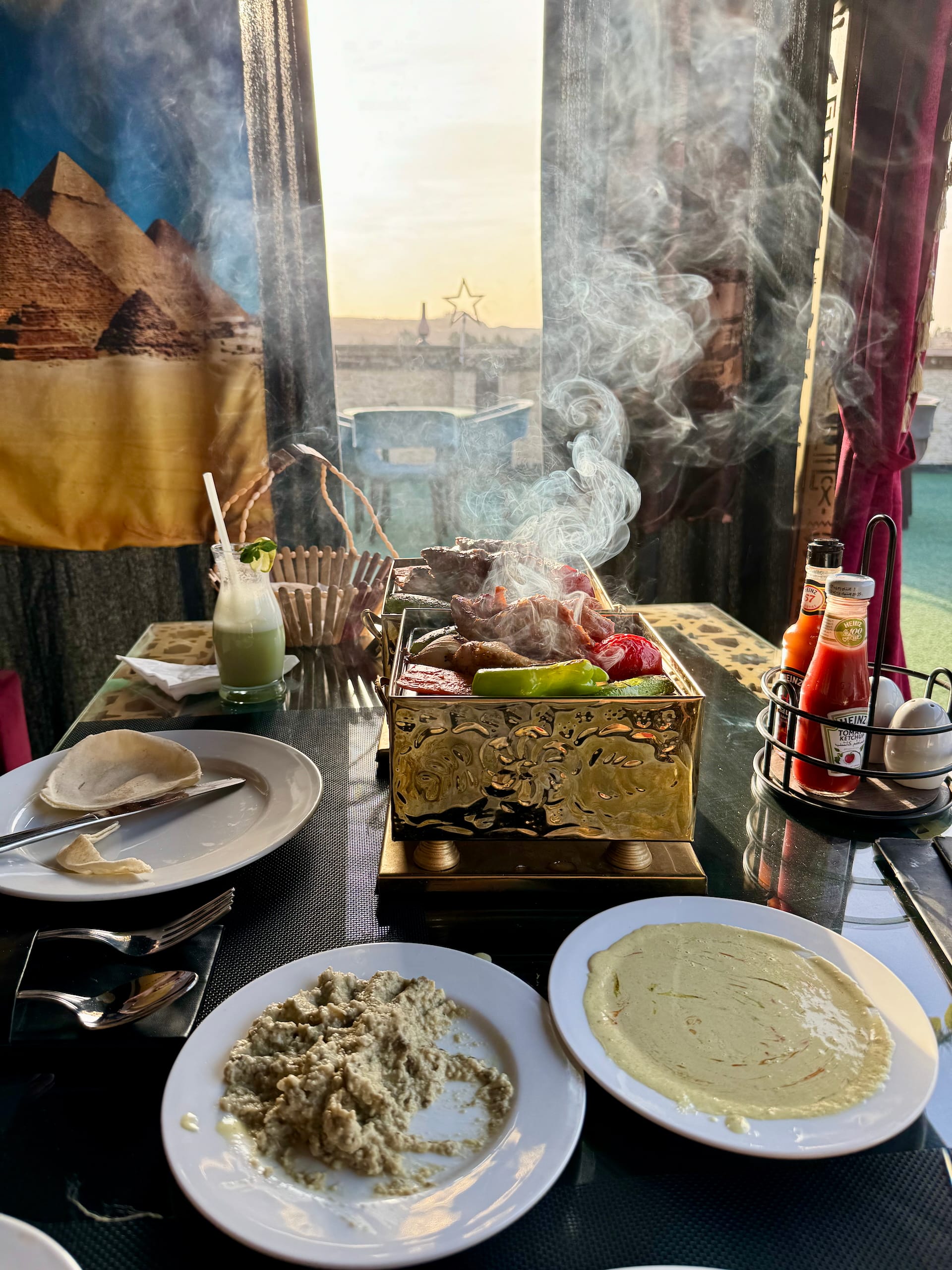
I also read that in supermarkets, they ring up more items for tourists than they actually bought, and this is hard to catch immediately if you don’t speak (read) Arabic. Once I almost thought they had scammed us at the shop near the hotel because I saw five identical (small) strange amounts on the receipt, but then I realized we had bought a six-pack of sweets that somehow only had 5 pieces in it, and not only didn’t they scam us, we specifically only had to pay for the 5 pieces.
It’s true that everything in Egypt revolves around baksheesh, or tips, but except for Dahshur, no one expected this aggressively or made it known that this would be due for even the smallest thing. Besides the usual places (restaurants, Uber, guides), I didn’t give anyone anything, and there were no problems from this.
As for vendors and pushiness: let’s say they managed to get us a little bit here. The alabaster statuette I bought probably isn’t alabaster, but I already suspected this then and went into the game knowing this. What you also supposedly need to watch out for are papyrus sellers, since most of the time these are fake papyri, and they want to push them onto unwary tourists at much higher prices than would be realistic. Fortunately, neither guide took us to any papyrus sellers (the pyramid one asked if we’d be interested, but when I said no, he didn’t insist), but this situation can also arise when they just “drag you” into a shop from the street – or most often, they politely invite you in. In such cases, it’s always worth being alert.
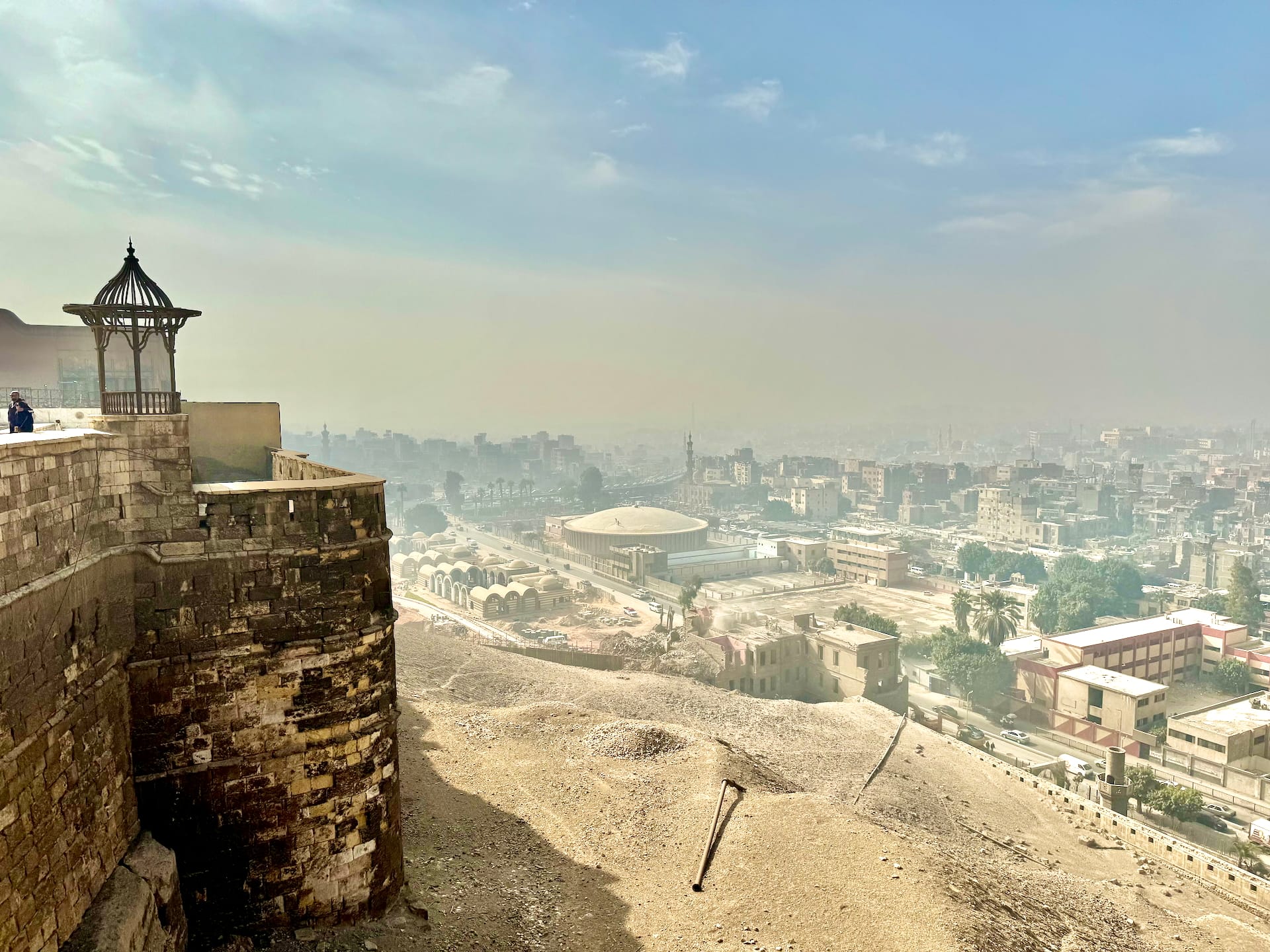
The vendors weren’t particularly pushy anywhere, in fact, I think the situation was much better than, say, in Morocco or Turkey. Maybe it helped that Esraa was with us in Khan el-Khalili; they still called out to us, but after a simple la, shukran (no, thank you), there was no further interaction. But even when we were wandering around the pyramids alone and they wanted to sell camel rides, for example, I didn’t feel unpleasant insistence: here too, a simple “no” was quite enough.
Overall, therefore – fortunately – we didn’t get into any truly unpleasant situations, no one scammed us, in fact, everyone was particularly very kind, so my earlier fears were unfounded. It’s worth keeping in mind that Egypt isn’t necessarily the easiest travel destination, but with a little attention and preparation, even for such a short time, it can offer wonderful experiences.

